Fumble in Football: Understanding Causes and Prevention Strategies
In American football, a fumble is a pivotal event where a player loses control of the ball before being downed or scoring. This moment is critical as it can dramatically shift the game’s momentum, potentially leading to game-changing plays. A fumble may occur due to reasons like a strong tackle, a player’s lack of grip, or unfavorable weather conditions making the ball slippery.
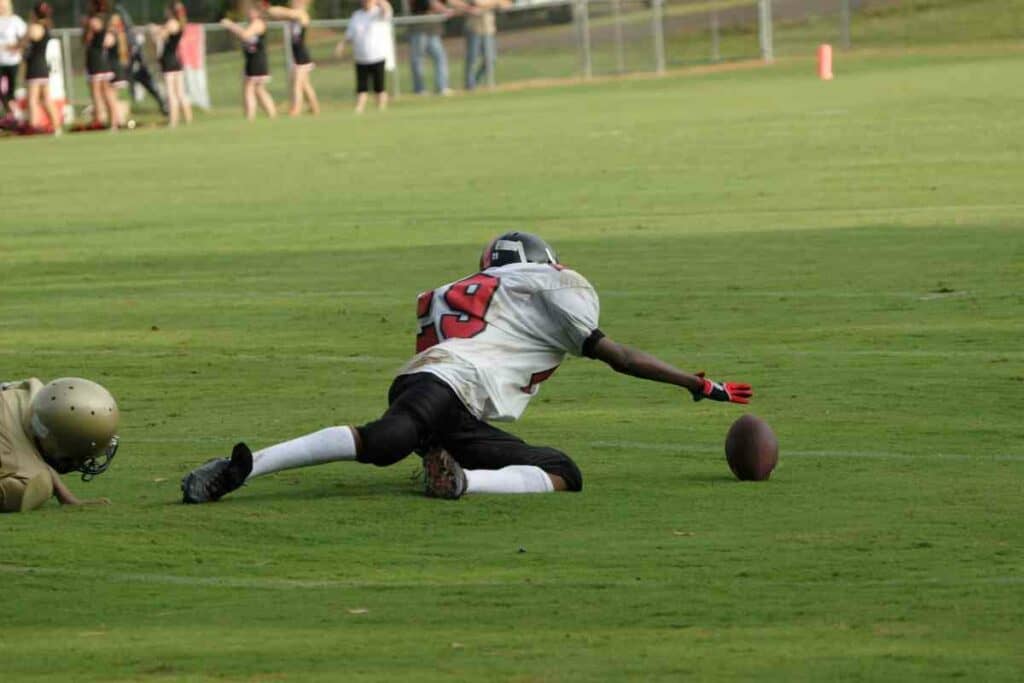
Related Post! A Comprehensive Guide To Every Football Position
What’s a fumble, and what happens when a football player fumbles the ball?
A fumble in football occurs when a player loses possession of the ball before being downed or scoring. Upon fumbling, the ball becomes live, allowing either team to recover it. The team that recovers the fumble gains possession, potentially altering the game’s momentum and field position, leading to turnovers or scoring opportunities.
Upon a fumble, the rules of football state that the ball is in a live state, open for recovery by either the offensive or defensive team. This creates a thrilling and crucial moment in the sport, as the team recovering the fumble gains possession, significantly impacting scoring opportunities and the game’s dynamics. Teams rigorously train to not only force fumbles but also to secure possession during these unexpected events.
Key Takeaways
- A fumble is the loss of ball control by the possessing player in American football.
- The rules allow any team to recover a fumbled ball, marking a critical juncture in the game.
- Teams strategize to both force and recover fumbles effectively.
Understanding Fumbles
Fumbles can abruptly alter a game’s course by unexpectedly shifting possession, making a thorough understanding of them essential.
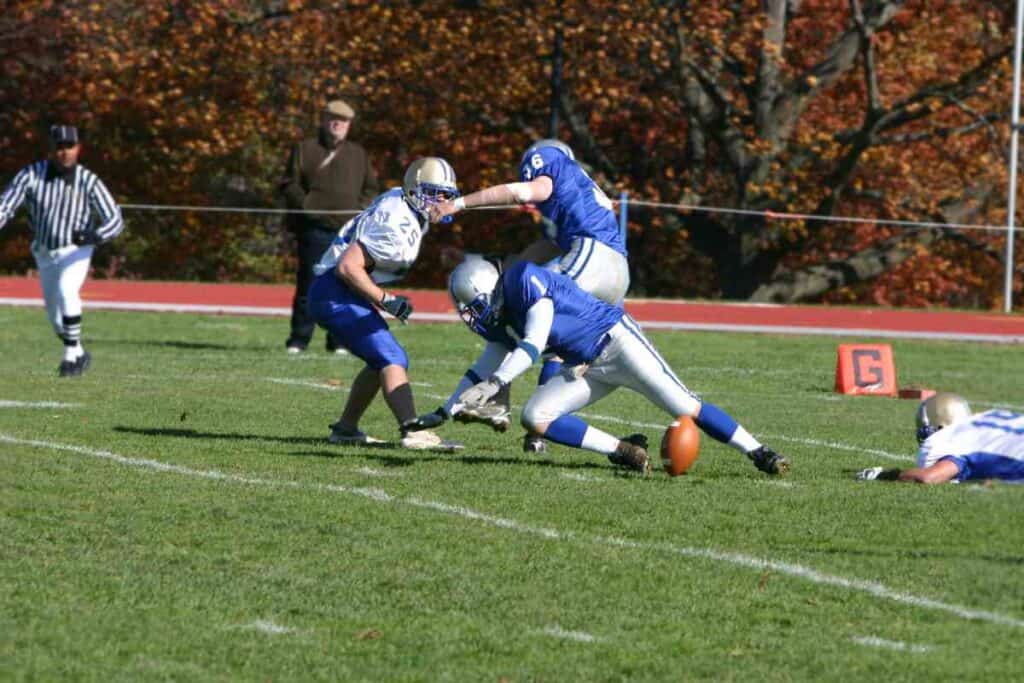
Definition of a Fumble
A fumble occurs when a player loses possession of the football before being downed or scoring. For a play to be considered a fumble, the player must have had full possession and control before losing the ball. Once the ball hits the ground post-fumble, it becomes a live ball, meaning either team can gain possession.
Causes of Fumbles
Fumbles can happen due to:
- Poor ball security: Failing to maintain a firm grip on the football.
- Strong hits from opponents: Especially hits targeting the ball.
- Risky play extensions: Such as reaching out with the ball, increasing the risk of dropping it.
Even the ground can cause a fumble in certain situations. Maintaining control over the ball is crucial, and players are consistently trained to enhance their grip and prevent fumbles.
Fumble vs. Incomplete Pass
Distinguishing between a fumble and an incomplete pass is important. If a player loses grip on the ball during a pass attempt, and it moves forward without any player gaining control, it’s deemed an incomplete pass, not a fumble. A play is ruled a fumble when the player had control of the ball and made a football move, like tucking the ball to run, before losing possession.
The Rules Governing Fumbles
In the NFL, a fumble is a significant event where a player loses possession of the football before being down by contact, presenting an opportunity for either team to gain control of the ball.
Related Post! Football Teams With The Most National Championships
NFL Rulebook on Fumbles
The NFL’s rules on fumbles are outlined in Rule 8, Section 7, Article 3 of the official rulebook. A fumble results in a live ball, open for recovery by either the offensive team (Team A) or the defensive team (Team B), with specific rules applying based on who recovers the fumble and where.
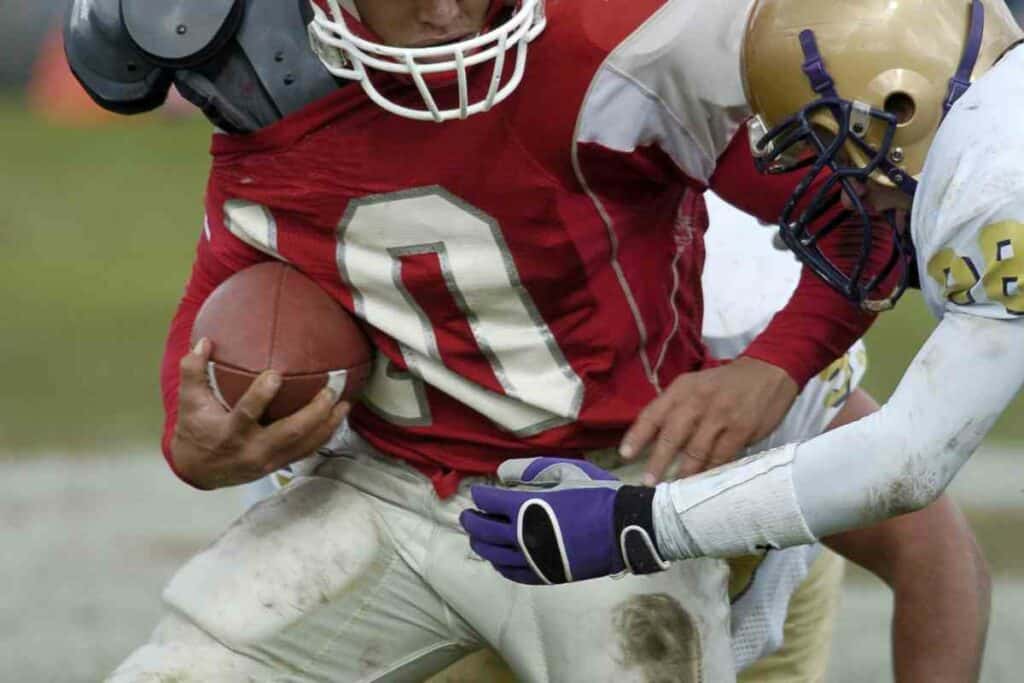
Turnovers and Fumble Recoveries
- Team B Recovery: If Team B recovers a fumble, it results in a turnover, and Team B starts a new set of downs.
- Team A Recovery: If Team A recovers its own fumble, the play continues, barring the ball going out of bounds or the player being down by contact.
- Out of Bounds: If the ball goes out of bounds, the last team in possession retains it.
The Tuck Rule
The tuck rule, abolished in 2013, previously treated certain fumble scenarios as incomplete passes. Its removal emphasizes the live-ball nature of fumbles, ensuring clarity and fairness in recovery opportunities.
Player Actions and Fumbles
Understanding fumbles is crucial in football, as player actions during a fumble can significantly impact the game’s outcome.
Recovering a Fumble
To legally recover a fumble, a player must gain clear possession before being tackled or the ball going out of bounds. Post-recovery, the team can advance the ball after the fumble, with certain restrictions on fourth down or after the two-minute warning.
Steps for Recovering a Fumble:
- Quickly identify the loose ball.
- Move toward the ball, mindful of opposing players.
- Securely grasp the football with both hands.
- Protect the football and brace for potential tackles.
Forced Fumbles and Stripping the Ball
Forcing a fumble involves targeted actions to dislodge the ball from an opponent’s hold. Defensive players can execute a strip by aiming for the ball during a tackle, using hands, helmets, or shoulder pads to jar the ball loose.
Techniques to Force a Fumble:
- Swipe or punch at the ball during a tackle.
- Use a helmet or shoulder pad to dislodge the ball.
- Pull or twist the ball from the carrier’s arms when in close proximity.
Focusing on these techniques allows players to potentially change the game’s direction by either recovering or forcing fumbles.
Fumbles in Play Progression
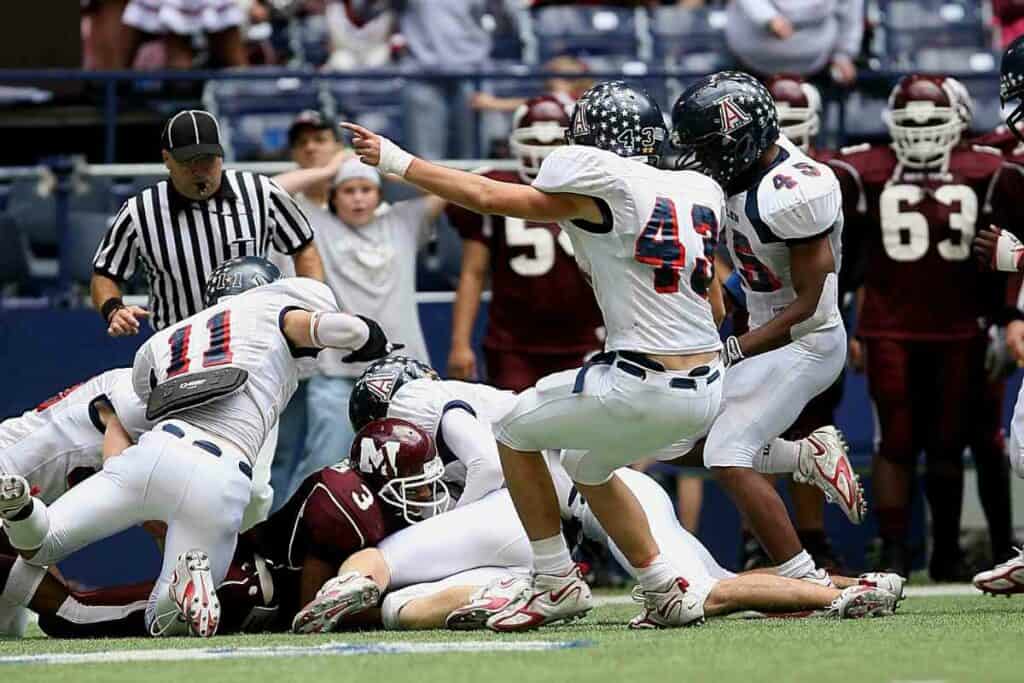
In football, a fumble is a critical event where a player loses possession of the ball during play, often leading to significant game shifts like turnovers or lost downs.
Fumbles on Running Plays
During running plays, the running back, typically the ball carrier, faces a high risk of fumbling, especially in congested areas. Fumbling on fourth down can be particularly detrimental, as it may result in a turnover and loss of an offensive opportunity. Thus, it’s crucial for the offense to maintain tight ball security to prevent the defense from stripping it during the play.
Fumbles on Passing Plays
In passing plays, receivers must ensure a secure catch to avoid fumbling after reception. If the quarterback is hit while attempting a pass, or if a receiver is tackled soon after catching the ball, there’s a risk of the ball being jarred loose. These fumbles can be game-altering, occurring in open play where both teams have a chance to recover the ball.
Special Teams and Fumbles
Fumbles in special teams plays, like kickoffs or punt returns, often result in unpredictable outcomes. Players fielding kicks must keep a firm grip on the ball, as fumbles here can cause confusion and rapid shifts in the game’s flow. For example, a muffed catch on a punt return can lead to a quick turnover, giving the kicking team an advantageous field position.
Consequences of Fumbles
Fumbles can dramatically change the game’s direction by affecting the score, possession dynamics, and field position.
Score Changes Resulting from Fumbles
- A fumble recovery by the opposing team can lead to an immediate scoring opportunity, including a touchdown return or a safety, depending on where the fumble is recovered.
Change of Possession Dynamics
- Fumbles offer a chance for possession change. If the opposing team recovers your fumble, they gain control of the ball, potentially stopping your offensive drive and shifting momentum.
Field Position After a Fumble
- Touchback: Fumbling the ball out of the opponent’s end zone or sideline results in a touchback, placing the ball on their 20-yard line.
- Yardage: The recovery spot of a fumble can lead to significant changes in field position.
- Momentum: The recovery location of a fumble can either put the recovering team in a scoring position or require them to recover lost ground.
In summary, each fumble carries impactful consequences that can significantly influence the game’s flow and outcome.
Strategies to Prevent Fumbles
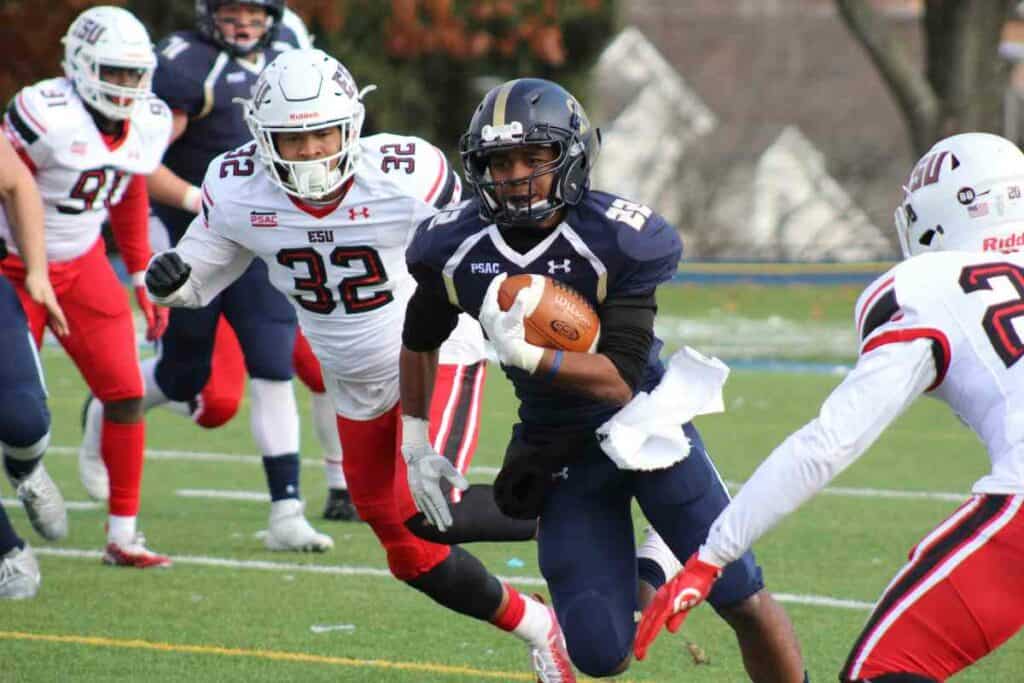
In football, preventing fumbles is key to maintaining possession and securing the game. Effective coaching techniques and player skill development are essential in fostering ball security.
Coaching Techniques for Ball Security
Coaches are instrumental in teaching players the fundamentals of ball security, using drills and consistent feedback to instill discipline and reduce fumble risks. Key techniques include:
- High and Tight Drill: Encourages players to keep the ball high on the chest and grip it tightly with the forearm and bicep.
- Pressure Points Practice: Focuses on protecting the ball’s pressure points for a firmer grip.
- Five Points of Contact Drill: Teaches securing the ball using the palm, forearm, bicep, chest, and thigh.
Emphasizing these techniques in practice helps players instinctively protect the ball during games, even under tough defensive pressure.
Player Skills Development
For ball carriers, developing strong ball-handling skills is crucial:
- Strengthen Your Grip: Perform exercises to build forearm, wrist, and hand strength.
- In-Game Awareness: Stay aware of the defense’s location and potential tackles.
- Practice Scenarios: Engage in drills that simulate game situations to enhance ball security under pressure.
Combining strength training with on-field practice is vital for effectively maintaining possession against aggressive defenses.
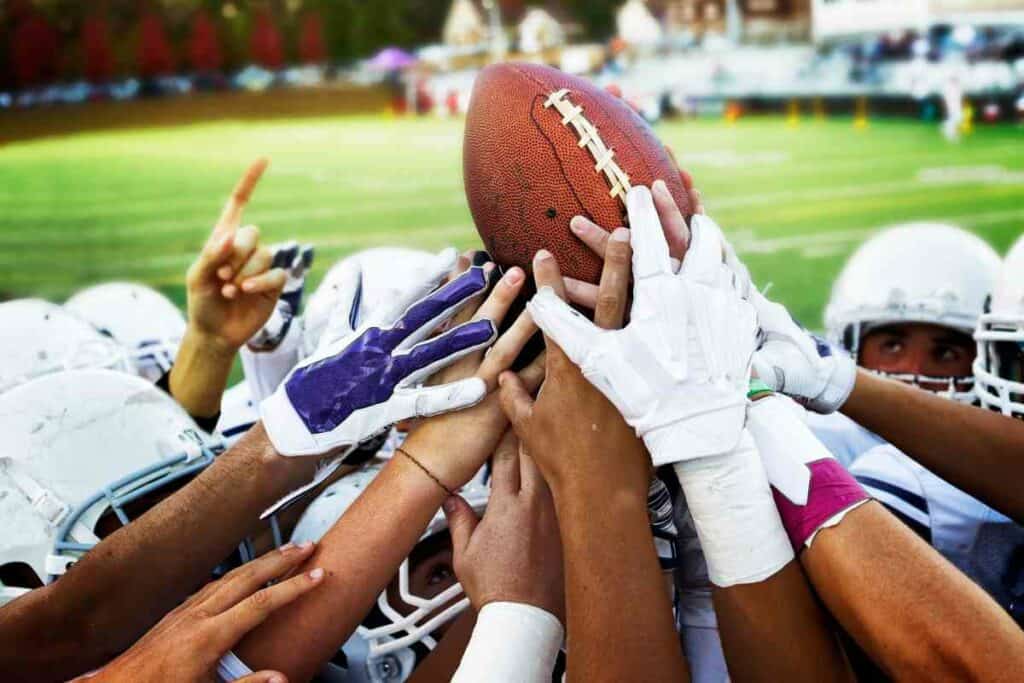
Fumbles in Football History
Fumbles have significantly impacted football, influencing both game outcomes and rule evolution.
Infamous Fumbles
- The Butt Fumble: Mark Sanchez’s 2012 fumble against the New England Patriots, resulting from running into his lineman’s backside, is infamous for its unusual nature.
- Orange Bowl Fumble: A pivotal fumble in the 1967 Orange Bowl led to a touchdown for the University of Nebraska, impacting the game’s outcome.
Historic Rule Changes Due to Fumbles
- Forward Fumble Rule: Post the “Holy Roller” incident in 1978, the NFL changed rules to restrict teams from advancing the ball on fumbles forward in the game’s final moments.
- Fumblerooski Ban: This once-legal trick play involving a deliberate fumble was banned for its deceptive nature, though it remains a notable part of football tactics history.
Understanding these historical aspects offers deeper insight into the strategies and rules of modern football.

Fumble Procedures and Official Calls
In the dynamic environment of football, the officiating and review of fumbles are critical for fair play.
Officiating Fumbles
- Referees determine if a player fumbled before being down by contact.
- If a fumble is recovered inbounds by the opposing team, they gain possession at the recovery spot.
- During the final two minutes or overtime, only the fumbling player can advance the ball.
Video Replay and Fumble Challenges
- Coaches can challenge fumble rulings, with booth reviews initiated in the final two minutes or overtime.
- Replay systems confirm or overturn field calls based on visual evidence, examining factors like whether the player’s knee was down before losing the ball.
Understanding these procedures is crucial for both players and fans to appreciate the game’s strategic and regulatory complexities.
Frequently Asked Questions
What constitutes a fumble in NFL football?
A fumble occurs when a player who has control and possession of the ball loses it before being down by contact or scoring. In the NFL, a player is considered down when any part of his body, except his hands and feet, touches the ground.
How does the play proceed following a fumble?
After a fumble, the ball is in play and can be recovered and advanced by either team. If the fumbling team recovers, they continue the drive; if the opposing team recovers, they gain possession at the spot of the recovery.
What is the rule governing fumble recoveries?
In the NFL, if the defensive team recovers a fumble, they can attempt to advance the ball towards the end zone. Fumble recoveries can result in a change of possession and potentially a defensive touchdown.
What differentiates a fumble from an incomplete pass?
A fumble is distinguished from an incomplete pass by whether the player had control and made a football move. An incomplete pass occurs when the quarterback’s throw hits the ground without being caught or if the receiver does not control the ball before dropping it.
Which techniques are effective for causing a fumble?
Defensive players use techniques like the “punch-out” where they target the ball with a strong punch, and the “strip” where they attempt to pull or rake the ball out from the ball carrier’s grasp.
What are the specific rules regarding fumbles in touch football?
In touch football, fumbles are often treated differently. For example, the ball may be called dead at the spot of the fumble, and a turnover may or may not occur depending on the rules of the league.
